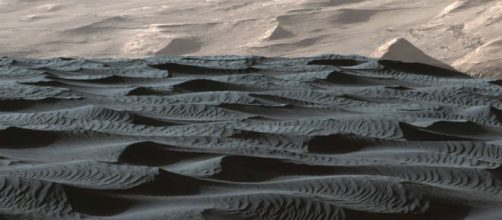The surface of Mars has revealed many environmental features that are common to the features seen on earth; however, a recent observation of the sand dunes on Mars revealed strange dune patterns that are not related to what one could see on sand dune forming regions on earth. This strange features are related to Mars´ thin atmosphere and may provide new insights into its atmosphere evolution.
Sand dunes on Mars
Curiosity made the first observations of sand dunes on Mars six months ago in Bagnold Dunes, where it spotted sand dune formations which at closer look revealed a type of sand dune pattern that could not be recognized or compared to any type of sand dune on the surface of the earth; however, this unrecognizable type of sand dune was most related to the dunes formed under water.
Impact ripples
Images of sand dunes on Mars have been observed for years and have revealed ripples 3 meters (10 ft.) apart that are formed when the wind drags sand grains that eventually collide with sand grans in the ground. On earth, These types of impact ripples are common in sand dunes and beaches with grain sizes 0.3 to 2.5 mm wide and wavelengths in between 7-14 cm. usually impact ripples have straight or slightly sinuous crests.
The one meter scale crest of ripples on Bagnold Dunes are sinuous, not exactly like impact ripples, but more like ripples forming underwater on earth. Moreover, on top of the surface of these big-sized ripples were found ripples of the same form and size similar to those found on earth?
Thin wind on Mars
In addition to the sinuous crests, one face of the ripple is steeper, while the opposite face is not. It´s thought that the one meter size ripples are formed by the thin Martian wind dragging small grain particles, in the same way that flowing water carries sand grains on earth.
Underwater dunes
These types of dunes form on beds of sand and gravel and are driven by water flow. They are common in rivers and estuaries, dunes form when the upstream sand deposits are eroded and deposited downstream, forming as continuous patterns of dunes and showing similarity in their height and wavelength. It’s believed that gravity and the thin atmosphere could be contributing to the formation of the mid-sized ripples of the Martian sand dune environment. Future science studies are expected to provide conclusive knowledge about the formation of these types of features on the red planet.

